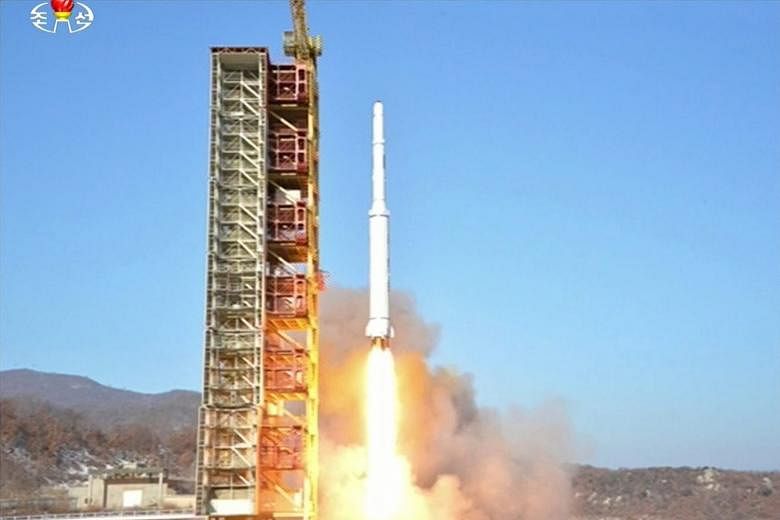SEOUL • South Korean and United States defence officials said yesterday they would begin formal talks on the deployment on the Korean peninsula of a US missile defence system to counter the growing threat from North Korea. The announcement followed a North Korean rocket launch yesterday that the US and its allies condemned as a covert ballistic missile test.
Mr Yoo Jeh Seung, South Korea's deputy defence minister for policy, said: "It has been decided to formally start talks on the possibility of deploying the Thaad (Terminal High-Altitude Area Defence) system to South Korea as part of steps to bolster the missile defence of the Korea-US alliance."
For years, there has been speculation about the deployment of the Thaad system - one of the most advanced in the world - to South Korea, which is among Washington's main Asian allies.
The US insists that it is a deterrent necessitated by the North's advancing ballistic missile programme, while China and Russia argue that it would undermine stability and could trigger an arms race in a delicately balanced region.
But Mr Yoo stressed the Thaad system - if deployed - would "operate only regarding North Korea".
Late last month, the US Missile Defence Agency conducted a successful test of a new ground-based US missile defence system built to destroy incoming ballistic missiles by hitting them while they are still in space.
Speaking in response to North Korea's rocket launch, Major-General Kim Yong Hyun, the chief operations officer at South Korea's Joint Chiefs of Staff, told lawmakers yesterday the upcoming annual joint US-South Korea military exercises will be the largest held.
The Key Resolve and Foal Eagle exercises, to be staged the next two months, will boast the "most cutting-edge" technology, Maj-Gen Kim said.
In an apparent show of force, the USS John C. Stennis, a US nuclear-powered aircraft carrier, will be mobilised during the drills, a South Korean military official was quoted by Yonhap news agency as saying.
The North Korean launch drew widespread condemnation. US Secretary of State John Kerry called the firing "a flagrant violation" of United Nations Security Council resolutions, while South Korean President Park Geun Hye said the launch was an "unacceptable provocation" and called for additional sanctions to be levelled at Pyongyang.
A Singapore Ministry of Foreign Affairs spokesman said in a statement: "We are appalled by this series of deliberate and provocative actions of the DPRK (Democratic People's Republic of Korea)... We strongly urge the DPRK government to refrain from further provocation, abide by its international obligations, and return to negotiations immediately."
Chinese Foreign Ministry spokesman Hua Chunying said her nation "regrets" the use of ballistic missile technology to conduct the launch, while urging a "calm" response.
"The Chinese side always maintains that dialogue and consultation is the only way to ensure lasting peace and stability in the region," she said in a statement.
Russia said the move was a serious blow to regional security, including that of Pyongyang. France condemned the launch as a "senseless provocation" and called for a "rapid and tough" response from the UN Security Council. Britain and Australia have also expressed concern.
AGENCE FRANCE-PRESSE, BLOOMBERG, XINHUA, REUTERS

